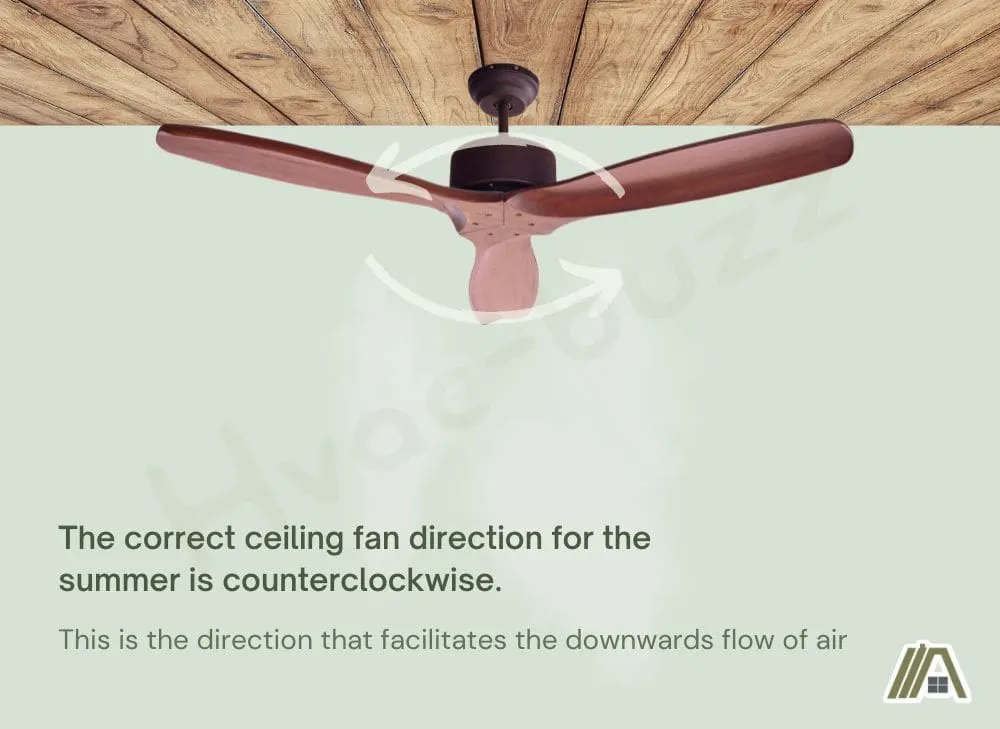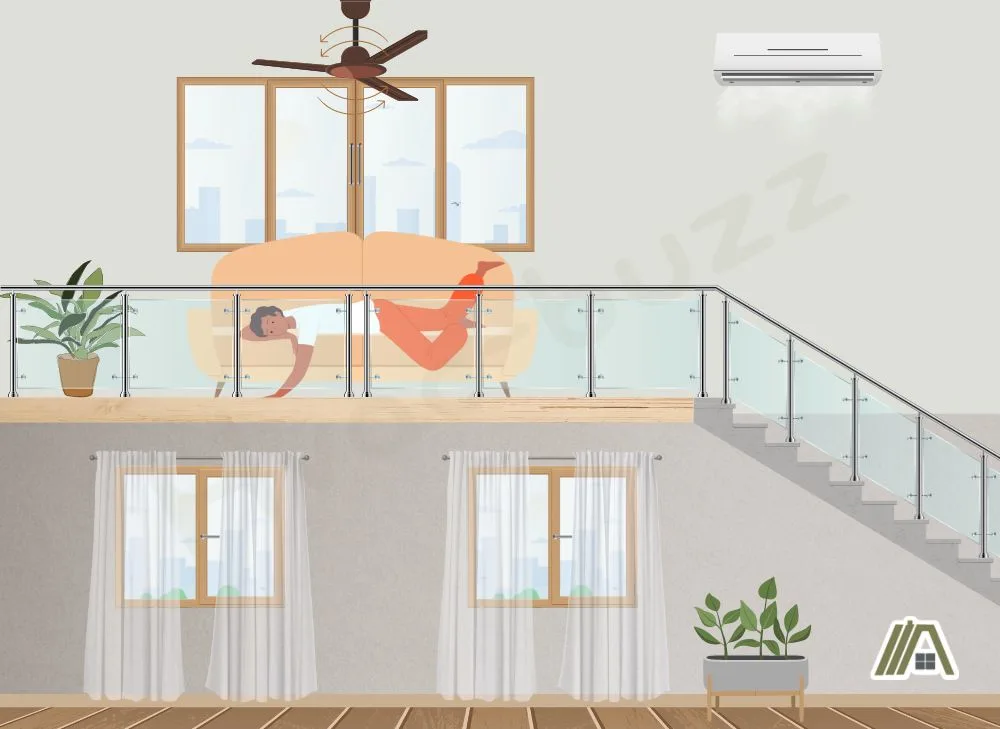A loft can be an aesthetically pleasing addition to a home and an inexpensive way to get extra space. One of the only downsides to a loft, though, is that they are higher up in the home but still included in the general area and, therefore, are often warmer than the lower areas of the home.
Adding a ceiling fan to your loft can cool both the people in the room and the room itself (under certain conditions). It all depends on direction, position, and if you are using it with the AC.

To cool a loft, set the ceiling fan to spin counterclockwise. This pushes rising hot air out of the loft. To cool people in the loft, counterclockwise rotation facilitates wind chill and evaporative cooling. Center the fan over the occupied space. Use the fan with AC to enhance cooling and air circulation.
Cooling Depends on Air Flowing Over People
Although a blowing fan may seem like it is cooling the air, this is not the case. A fan does not cool the air because it does not change the temperature in any way; it just moves air around.
But while a ceiling fan does not cool the room, it does cool people.

So, how does a fan cool you down? Well, they do this through the wind chill effect.
The best way to explain the wind chill effect is to imagine a protective layer of heat enveloping your body. This is something that forms naturally—it is a biological adaptation to improve our insulation.
If this layer is removed, your body is no longer insulated by this heat barrier. Instead, it is now exposed to the actual temperature of the room, which is typically much cooler than your body temperature. This provides a cooling effect.
Fans sweep away this heat when they push air over people.
Along with the wind chill effect, air being blown on the skin increases the rate at which our bodies lose heat through convection and evaporation.
At higher ambient temperatures, you are likely sweating, which means that the moving air will wick away your sweat and cool you via evaporative cooling, which is something you are likely more familiar with.
Possible Exception
Although fans do not have the ability to cool air, they can, in some cases, aid in lowering the temperature of the air in a loft.
Because lofts are higher in the home and heat rises, the loft is likely to have warmer air than the floors below it. Lofts also often share open floor plans with the rooms below. This makes it easy for the warmer air from the lower parts of the whole space to gather in the loft, which is closer to the ceiling.
By turning on your ceiling fan, you can push this warmer air down and out of the loft area. In effect, you are cooling the loft because the warmer air can be replaced with cooler air.
Ceiling Fan Must Rotate Counterclockwise Direction
The correct ceiling fan direction for the summer is counterclockwise, and this is true for any circumstance where you desire a cooling effect. This is the direction that facilitates the downwards flow of air.

When the ceiling fan is rotating counterclockwise, the highest point of the pitched blades should be leading. This ensures that the air is being forced downwards. I have provided an easy-to-understand visualization of why in Which Way Is Counterclockwise on a Ceiling Fan.
In order to tell what direction your ceiling fan is spinning so that you can determine if the mode must be switched (this will only be a consideration in fans with a reverse switch), stand directly under the ceiling fan and look up while the fan is spinning on low speed..
Standing under the fan, you should be able to determine if the fan is spinning counterclockwise or clockwise. If it is spinning counterclockwise, you should also feel a breeze blowing over you, even at slow speeds.
Best Position for Ceiling Fan
For the best cooling effect, the ceiling fan should be placed above the area with the highest occupation. A good example of this would be above a couch.
This placement should also be away from tall furniture, such as a large bookshelf. These objects can impede airflow and decrease the fan’s cooling and air circulation effects.
Once this position has been found, the fan can be centered for aesthetic purposes. For example, instead of putting it above the couch, place it in the center of the sitting area, over a coffee table.
Planning for the installation of a ceiling fan must also take into account the clearances for a ceiling fan. Because clearances contribute to efficiency and safety, they are a very important step in planning.
For efficiency, the protection of the fan and furniture, as well as the safety of the people around it, it is best for the ceiling fan blades to be 8-10” below the ceiling, 8-9’ above the floor, and 18” from the walls.
In order to fit a fan safely in a loft, the loft must be approximately 8’8″ tall.
The nature and design of lofts do mean that they might not have ceilings high enough to allow the safe installation of ceiling fans. You may still be able to install a fan, but only if it is a flush mount as opposed to a standard downrod mount model.
Using Ceiling Fans with AC to Cool a Loft
Although the breeze from a ceiling fan can cool you off sufficiently some days, it may not be enough to feel comfortable. When a fan isn’t doing the job, introducing cooled air to your loft may be necessary.
In a situation where a ceiling fan cannot cool your loft enough on its own, AC can be used with a fan to cool your loft.
Loft Occupied By People
Using both the AC and a ceiling fan is especially useful when your loft is often occupied by people.

More people means more heat since there are more bodies producing heat. With the added heat of warmer months as well as the fact that the loft is higher and warmer air settled there, both a fan and the AC would be wise to use.
Cooling mechanisms in action with the combined ceiling fan and AC:
- Wind chill effect (affects you).
- Evaporative cooling (affects you).
- Rising warm air is displaced back to lower areas (affects you and the room).
- Cold air is introduced by the AC and circulated by the fan (affects you and the room).
Using the two devices together can also make your AC more efficient. Because you are experiencing all the cooling mechanisms described as opposed to just the cold air from the AC, you feel colder. This means that the thermostat doesn’t have to be set so low.
Loft Unoccupied By People
When the space is not occupied by people, then the ceiling fan can still help to distribute cold air.
Although a loft that is often unoccupied by people may not need as much cooling as one that is often populated, it is still wise to cool this area of your home as it is technically part of the entire living space below it.
However, as it is not occupied, the windchill effects and evaporative cooling of the ceiling fan cannot aid the AC because these cooling effects only work on people, not rooms.
Nevertheless, the ceiling fan can help distribute the chilled air from the AC more efficiently.
Sources
https://sacramentoappraisalblog.com/2017/07/12/price-ceilings-literal-ceilings-that-are-too-low/

